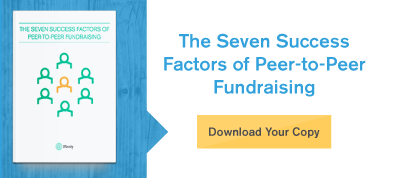Your Mission Matters, But Not To Everyone
Think about an organization you have a strong allegiance to – be it a nonprofit, sports team, political party, or university. You don its colors, share its values, follow its progress, and sing its praises to your networks. And chances are good that, despite your convictions and well-articulated case for support, you’ve at some point come face-to-face with someone who backs a rival entity or is simply agnostic. These encounters are frustrating, whether a disagreement over ACC v. SEC, Cardinals v. Cubs, or Bush v. Clinton. But when it comes to a cause connection to your nonprofit, things get personal. After all, your organization is valiantly trying to save the world by ending hunger, curing disease, preventing homelessness, or fulfilling any one of many worthy causes that everyone should care about.
It’s time to address the elephant in the room: your cause doesn't matter to everyone.
While that truth may seem unfortunate or inconceivable, it’s the reality. Your audience has a myriad of options for philanthropic involvement and a number of unrelated distractions, like keeping up with a demanding career, pursuing hobbies, and serving on the PTA, that prevent your cause from being top of mind. For those reasons, pursuing and believing in a worthy cause simply isn’t enough to drive participation in your organization’s next event. But here’s the good news: you can overcome these barriers by leveraging experiential peer-to-peer dynamics, which aren’t driven by cause alone (in fact, there are three participant drivers: cause, community, and activity).
Here are three ways to convert cause agnostics into participants for your P2P program:
1. Double down on cause by storytelling. Your cause may not have caught on yet, but that doesn’t mean it is not worthy; on the contrary, your vision for the future deserves to be heard and supported. But even a well-crafted mission statement doesn’t do the justice of a personal anecdote or moving success story. To ignite your audience with passion, take them on a journey. Don’t read them your mission statement – show them a triumphant return to the starting line, photos from the wedding that almost never was, or a grinning high school graduate. Then let those images simmer. The story needs time to resonate. You’ll know it has when event registration is on the uptick.
Once at your event, experiential programs provide your organization the ideal platform for storytelling and building empathy. Peer-to-peer events are a forum where volunteers, staff, survivors, fundraisers, and researchers can come together to hear tales of healing, breakthroughs, and remembrance directly from your organization. Stories not only bridge the gap between your strategic objectives (revenue!) and your audience’s need for an emotional connection, but they also have inherent sharing power, which makes them network-friendly and easy for your constituents to impart upon their friends after the event is over.
Takeaway: If you have a significant following and a large untapped potential pool of people, your cause should lead your messaging. Storytelling will attract the type of people who will engage and fundraise, which is the primary reason to have a peer-to-peer event.
Spend time working, reworking, and delivering your impact stories to perfect your storytelling. If you’ve already deployed your finessed story before, on, and after event day, and you feel strongly that your cause will not resonate quickly enough to reach your goals, then you can fast-track the process. Intensify your story’s impact by leveraging the other two participant drivers: activity and community.
2. Recruit through the activity. If your cause lies outside of the frame of reference for some, incorporating a tried-and-true activity into your program can facilitate bridging that gap. Don’t be afraid to tap into an existing activity-centric community, even if it isn’t the shiniest or newest on the event block. Running is by far the most prevalent example. A second running boom is sweeping both the United States and the world, and it can and should be taken advantage of (according to Running USA, over 19 million people crossed the finish line of a running event in 2013). Why not leverage the strength of that existing community?
It is critical to select an activity for which your constituents have both an interest and the ability to participate. If your target audience is too old or too adventurous for the traditional 5K, consider a walk or an endurance event. Bring your cause to your constituents where they are and where they want to be, and then make your ask. And remember that the activity is a vehicle for storytelling, and not a replacement for it. Similarly, paying a nominal registration fee and showing up on event day is no substitute for fundraising. At the end of the day, everything should harken back to more mission impact.
Takeaway: Choose an accessible, interesting activity to bridge the gap between your organization’s story and your constituents’ desire to play a role in shaping it.
3. Build a community. Most of us have attended a concert or sporting event because we simply couldn’t say no to the invitation of a passionate friend or family member. Many of us enjoyed ourselves. And some of us even became fans and decided to return on our own. The power of community is what converts attendees into fans, and registered participants into fundraisers. A community is a tribe – a group of passionate individuals united by a cause, supported by relationships, and identifiable by their terminology, language, or dress. Empower and support your core constituents to form bonds with one another to form a community. The human element will keep them coming back year after year, even if the activity changes or their preferences evolve.
Mud and obstacle events are a terrific recent example of this phenomenon. If given the option, most people would probably pass on being electrocuted or filling their mouths with muddy water. The appeal, however, of racing alongside and among a community of tough, adaptable people is much higher. Being a member of a Tough Mudder-type community is a badge of honor and testament to toughness of character – and well worth the grit and grime of race day.
Takeaway: Build a strong community to foster relationships among your constituents and you will ensure repeat participation and fundraising, even when their activity preferences and options evolve.
If your cause is thousands of miles away from your target audience or your story is nuanced and difficult to tell, you can still be successful in unlocking mission impact through P2P fundraising events. Keep cause front and center, but also lean on an enticing activity and a strong community to get folks in the door on event day. Once you have their attention, tell the compelling and meaningful story of why your mission needs their support. Trust in your passion and the worthiness of your cause – and remember that the world needs you to unlock the abundance out there.
Share this
You May Also Like
These Related Stories

The Complete Guide to Leveraging P2P Networks
How To Acquire, Recruit, & Retain Fundraisers In A Peer-to-Peer World



No Comments Yet
Let us know what you think